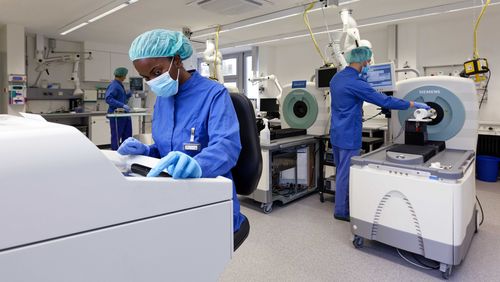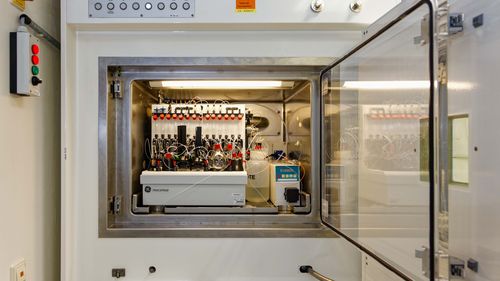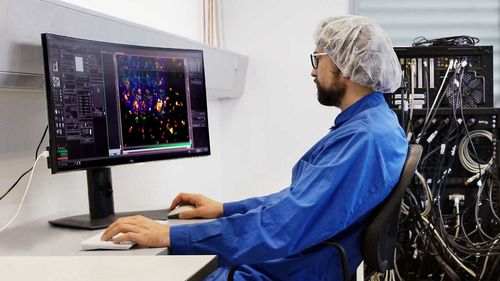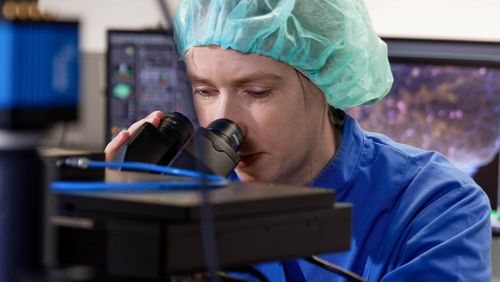
Future scans
The Werner Siemens Imaging Center has elevated the University of Tübingen to the premier league of research on medical imaging technology. The overarching goal? To better understand illnesses, to diagnose them earlier—and to treat them more effectively.
An MRI image of a painful back, a PET scan in case of a suspected tumour: medical imaging technology such as magnetic resonance imaging (MRI) or positron emission tomography (PET) has become an indispensable instrument in clinical care and medical research. At the University of Tübingen, medical imaging technology numbers among the core research priorities. The Werner Siemens-Foundation has been supporting this work since 2007.
Leader in medical imaging technology
Founded in 2014, the Werner Siemens Imaging Center (WSIC) is the only one of its kind in the whole of Europe. The centre, which quickly became an internationally leading research institution for medical imaging, places its focus on preclinical research, namely, basic research done on cell and animal models, including the development of medical imaging instruments for small animals such as mice. The findings should shed light on how illnesses arise, develop and spread through the body, with the ultimate objective of developing better treatments. The spectrum of disciplines at WSIC encompasses oncology, neurology, cardiology and immunology.
Physicist and biomedical specialist Bernd Pichler is head of WSIC and holds the Werner Siemens Foundation Endowed Chair for Preclinical Imaging and Medical Imaging Technology.
Combining MRI and PET
The approximately 60 members of the team at WSIC unite specialist knowledge from the fields of biology, physics, medicine, chemistry and engineering science. The team’s core interdisciplinary approach has already achieved considerable success: for instance, the world’s first scanner able to combine magnetic resonance imaging (MRI) and positron emission tomography (PET) in a single instrument was developed at the centre. And the Siemens group has already incorporated this innovative technology into its line of medical instruments.
And the researchers’ interdisciplinary approach continues to lead them even further. They are currently working to integrate medical imaging technology with analyses and research findings from areas such as microscopy, protein analysis (proteomics) and metabolic analysis. “Our goal is to create multi-modal instruments capable of depicting and combining information from various analyses. This would greatly improve physicians’ ability to diagnose a disease and thus allow a more precise, personalised therapy,” says Bernd Pichler.
Using AI to interpret data
In order to manage the huge data volumes produced by medical imaging technology, the team at the centre is working to improve data interpretation by using artificial intelligence. Key measures include “machine learning” and “deep learning”—techniques in which algorithms are used to analyse data and, for instance, to recognise pathological changes in cells and organs that are depicted on the images.
Innovative biomarkers
Earlier diagnosis, better understanding and targeted treatments of disease are the goals, but improved medical imaging isn't enough—tiny little helpers, so-called biomarkers, are also essential. Biomarkers are radioactive or fluorescent chemical compounds able to indicate certain diseases. Currently, medical research worldwide is dedicated to searching for disease-specific biomarkers. They are invaluable in medical care, as they allow diseases to be diagnosed more easily and with a lower incidence of error. In addition, biomarkers help to monitor the course of a disease and the success of a therapy.
Identifying infections
The Werner Siemens Imaging Center is a major sponsor of biomarker research, with particular focus placed on biomarkers that can be traced using medical imaging technology. Among the major achievements at WSIC is research into pulmonary infections caused by the fungus Aspergillus fumigatus. Many infected patients die because the fungal infection is extremely difficult to differentiate from a bacterial infection; as a result, it’s frequently diagnosed and treated incorrectly. The researchers have now succeeded in developing biomarkers able to detect infected areas in the lungs of mice at a very early stage.
Biomarkers for Alzheimer’s and Parkinson’s
In addition to its work on medical imaging, WSIC has received international acclaim for its research in neurology and oncology. In these fields, priorities include developing biomarkers for neurodegenerative diseases such as Alzheimer’s or Parkinson’s, and examining the efficacy of innovative immunotherapies in cancer treatments.
From research to clinical care
To ensure that patients profit as soon as possible from the latest findings, the Werner Siemens Imaging Center collaborates closely with the University Hospital Tübingen. A group of researchers and physicians at the centre are working on translating promising basic research into clinical care. At present, the team is engaged in clinical studies on diagnosing Aspergillus fumigatusinfections and working towards better diagnostics of breast cancer.
Text: Adrian Ritter
Photo: Frank Brüderli






